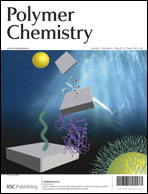Low-molecular-weight poly(propylene carbonate)s bearing –OH groups at both ends (PPC-diols) are prepared by feeding protic chain-transfer agents (1,2-propanediol, terephthalic acid, 2,6-naphthalenedicarboxylic acid, and phenylphosphonic acid) in the CO2/propylene oxide copolymerization catalyzed by a highly active Salen–Co(III) complex tethered by four quaternary ammonium salts. The generated low-molecular-weight PPC-diols are used in situ for the formation of thermoplastic polyurethanes through subsequent feeding of diisocyanates (4,4′-methylenebis(phenyl isocyanate), 1,4-phenylene diisocyanate, and toluene 2,4-diisocyanate). The formation of polyurethanes is confirmed by 1H NMR spectroscopy and GPC studies. By varying the structure of the fed diisocyanate and chain-transfer agent, the glass transition temperature of the polyurethane can be tuned in the range 40–60 °C. A high glass transition temperature of up to 60 °C, which is 20 °C higher than that of high-molecular-weight PPC itself (40 °C), is attained when 2,6-naphthalenedicarboxylic acid (as the chain-transfer agent) and 4,4′-methylenebis(phenyl isocyanate) are employed. In addition, flame-retarding polyurethanes are generated by using an organophosphorus-based chain-transfer agent.


 Please wait while we load your content...
Please wait while we load your content...